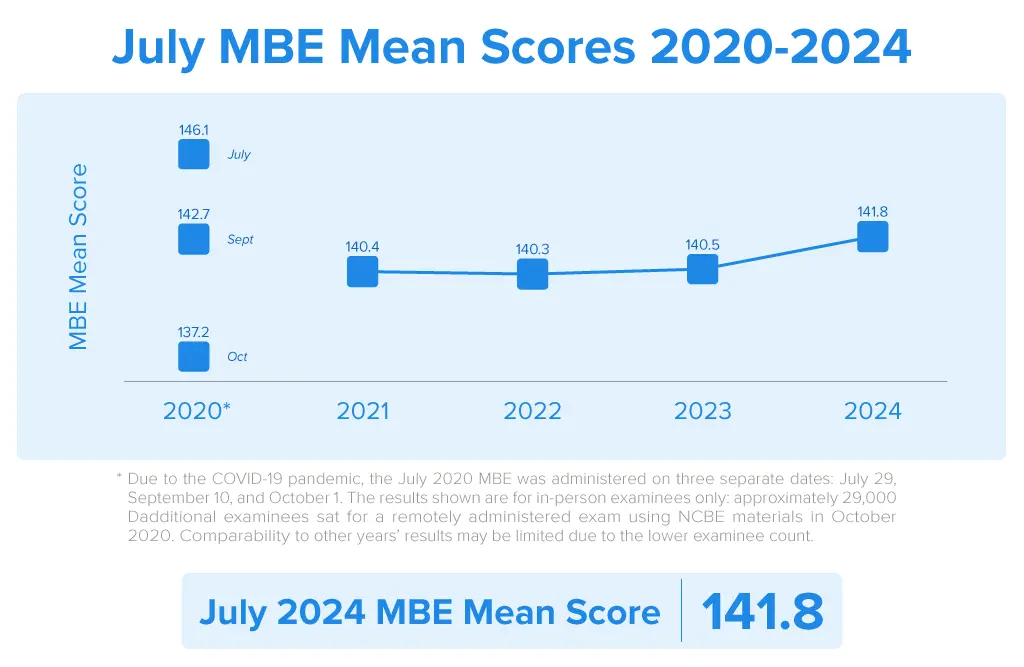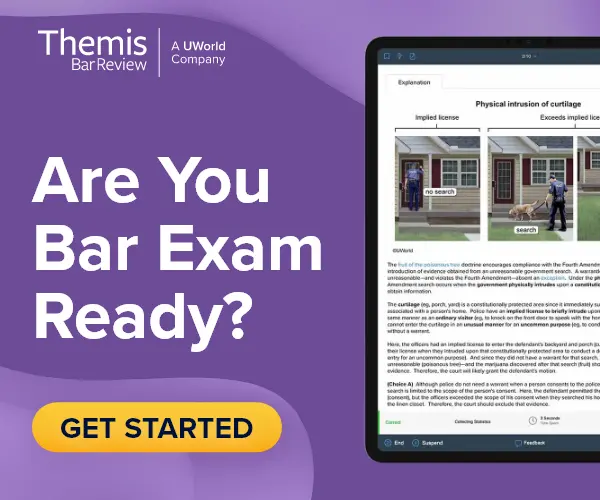Each MBE question is worth 1 point. The maximum raw score you can get is 175 because 25 of the 200 questions are unscored pilot questions used by the NCBE to test future exam items. There’s no way of identifying unscored questions, so all questions should be treated equally. The raw score is then scaled from 0 to 200 to account for variations in test difficulty.
There are 25 questions for each of the 7 MBE subjects, which include:
- Civil Procedure
- Constitutional Law
- Contracts
- Criminal Law and Procedure
- Evidence
- Real Property
- Torts
MBE Scaled Score vs. MBE Raw Score
Your raw score is simply the number of answers you answered correctly on the MBE. Your score report reflects a scaled number. The NCBE uses a statistical “equating” method to calculate scaled scores that adjust for variations in difficulty across different exam versions.
For instance, if Exam A is harder than Exam B, raw scores would not compare equally. Equating balances the difference, inflating scores from harder versions and adjusting those from easier versions. This ensures fairness across exam administrations.
How to Calculate Your Scaled MBE Score
There is no way to accurately calculate your scaled MBE score because the NCBE doesn’t release the details of its process. However, a general rule of thumb is to add 10-15 points to the number of questions you answered correctly.
MBE Passing Scores by Jurisdiction
Your score on the MBE matters, especially if you are trying to transfer it. Passing standards range from 130 to 143. Keep in mind that the MBE score is only part of your Uniform Bar Exam (UBE®) score. A stellar Multistate Essay Examination (MEE®) and Multistate Performance Test (MPT®) scores can help offset a lackluster MBE score.
How MBE Scores Contribute to UBE Passing Requirements
Since the MBE is worth 50% of a total UBE score, you can divide a jurisdiction’s UBE minimum passing score in half to get a “passing” MBE score. For example, the minimum passing score for the UBE in Alabama is 260. Therefore, you want to aim for an MBE score of 130 or higher. However, if you get a 128 on the Alabama MBE and a 132 on the other portions, the sum of your total score is 260, which is still passing.
|
“Passing” MBE Scores (½ of the UBE score) |
Jurisdiction |
|---|---|
| 130 | Alabama, Minnesota, Missouri, New Mexico, North Dakota, Utah |
| 132 | Indiana, Oklahoma |
| 133 | Connecticut, District of Columbia, Illinois, Iowa, Kansas, Kentucky, Maryland, Montana, New Jersey, New York, South Carolina, Virgin Islands |
| 134 | Michigan |
| 135 | Alaska, Arizona, Arkansas, Colorado, Idaho, Maine, Massachusetts, Nebraska, New Hampshire, North Carolina, Ohio, Oregon, Pennsylvania, Rhode Island, Tennessee, Texas, Vermont, Washington, West Virginia, Wyoming |
Non-UBE MBE Passing Scores
Non-UBE MBE passing scores are more challenging to calculate. For example, California’s bar exam passing score is 1390 out of 2000 points. You should aim for a scaled score of 139 on the MBE, but there is no way to accurately gauge what raw score you need.
If you’re taking the bar exam in a non-UBE jurisdiction, check out our state-specific bar exam pages:
The MBE accounts for 50% of the total bar exam score in all UBE jurisdictions. However, a few non-UBE jurisdictions have different weightings. In Mississippi and Nevada, the MBE is weighted at 40%, while in Virginia, it makes up 33% of the total score. South Dakota and Puerto Rico do not combine MBE scores with written component scores, which may affect the overall scoring structure in those jurisdictions.
How to Transfer Your MBE Score
The NCBE submits MBE scores directly to the appropriate jurisdictions. To get your MBE score, you have to ask for it, although not all jurisdictions offer this service.
- Step 1: Determine if the jurisdiction accepts transferred MBE scores.
- Step 2: Determine if your MBE testing jurisdiction authorizes the NCBE to transfer MBE scores.
- Step 3: Log in to your NCBE Account, submit an MBE Score Transfer Request, and pay the associated fee.
Jurisdictions That Accept Transferred MBE Scores
The following jurisdictions accept MBE scores individually:
- Georgia
- Mississippi
- South Dakota
- Virginia
- Wisconsin
- Northern Mariana Islands
- Palau
- Alabama
- Idaho
- Kansas
- Michigan
- Minnesota
- Missouri
- West Virginia
- Virgin Islands
How UWorld Can Help You Improve Your MBE Score
By practicing thoroughly with trusted bar prep resources — including UWorld, Themis Bar Exam, and Aspen Publishing — you can improve your MBE score and pass the bar on your first attempt.
- Practice with NCBE-licensed questions from past exams.
- Make sure you have good outlines.
- Memorize the black-letter law with spaced-repetition flashcards.
- Take practice tests that simulate the exam-day experience.
- Routinely identify knowledge gaps and study accordingly.
Learn More












